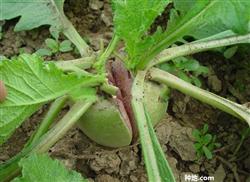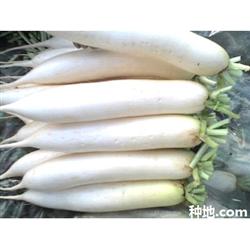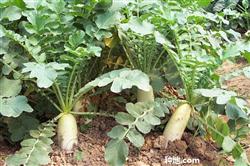How to prevent and cure the split root of radish?

How to prevent and cure the split root of radish? Please guide the reasons why white radish should be different from cracking roots and prevent abnormal roots such as decentralization and bending of radish fleshy roots, as well as fleshy roots cracking and forming cracked roots are common phenomena in production and important problems affecting yield and quality. There are bilateral roots on the fleshy roots of radish, and these lateral roots will not expand under normal cultivation conditions. However, under special conditions, the lateral roots can be enlarged, resulting in two or more decentralization. When the tillage layer is too shallow, the downward growth of the fleshy root is blocked, which will make the fleshy root bent or deformed. 1. Soil condition: hard and special materials such as stones, bricks and tiles are mixed in the soil, or articles such as plastic film and glass are mixed with Lahu fertilizer, which hinders the normal elongation and expansion of straight roots, and non-fleshy roots are in the process of elongation. When the main root encounters the above-mentioned substances, the elongation of the main root will cause the lateral root to expand and form decentralization or bending. Radish taproot expansion requires good soil ventilation and high oxygen content. if the amount of irrigation or soil water content is too high during the fleshy root expansion period, poor ventilation and physical extrusion will inhibit the taproot hypertrophy. However, when the soil aeration condition is slightly improved in the later stage of fleshy root expansion, the lateral root expands and forms a "whisker" lateral root. Under the conditions of soil consolidation, shallow tillage layer and heavy soil texture, it will also hinder the normal expansion of fleshy roots, resulting in rooting or bending. In general, long-shaped varieties are more likely to produce abnormal roots than short-shaped varieties. 2. Fertilization status it is easy to cause abnormal roots when applying a large amount of immature compost, livestock manure and other organic fertilizers or too high concentrations of urea, ammonium bicarbonate and other chemical fertilizers in radish fields. This is because when the tip of radish taproot encounters fermented compost, high concentration of livestock urine or chemical fertilizer, it often dies, breaks or inhibits growth, and cannot continue to elongate, while the lateral root expands to form branched or curved roots. In addition, in the fleshy root expansion period, topdressing too much nitrogen fertilizer results in luxuriant leaves, which is not conducive to the expansion of fleshy roots, but also easy to make lateral roots expand or main roots bend, forming bifurcated roots or curved roots. 3. Temperature status the sowing time of spring radish is generally from November to April of the following year, which coincides with winter and spring, when the air temperature and ground temperature are low, especially when the tillage layer is below 15 cm, it is difficult to raise the ground temperature artificially, in case of continuous irrigation, the soil porosity decreases, the soil layer is compact, and it is easy to form a permafrost layer, which leads to the poor binding of the main root after breaking the belly of radish, affecting the expansion of the middle and lower fleshy roots and forming abnormal roots. Therefore, a month before sowing, buckle the greenhouse film to make the temperature, turn the plough layer deeply to extract the soil moisture, pour enough water after sowing, and cover the plastic film, which can solve the contradiction between water and temperature and ensure the normal growth of spring radish. 4. Soil pests and other underground pests in soil will expand lateral roots and bifurcate or deform if they bite the tip of radish young roots and inhibit the growth of taproots. Improper cultivation and management will also cause deformities of fleshy roots. For example, in some varieties with growing fleshy roots, sparse planting is more likely to bifurcate and bend than close planting. In management, one side of Hypocotyl of seedlings is often damaged and slightly curved roots are formed. Main measures to prevent malformed roots: cultivation plots should choose sandy loam with deep soil layer, no gravel, bricks and tiles, sandy loam with good drainage, deep ploughing fine rake, fine soil preparation, and removal of waste agricultural film; fertilization should be uniform, organic fertilizer should be fully mature, and appropriate amount of chemical fertilizer should be applied; proper irrigation should not cause soil stagnant water or soil consolidation; seedling, intertillage, weeding and other operations should be careful, do not cause mechanical damage to seedlings. To prevent soil pests in time, soil pesticides can be applied before sowing. Click for more radish planting techniques click to get more vegetable planting techniques
- Prev

How does growing white radish increase yield?
How does growing white radish increase yield? Please guide white radish digging heart can increase production 40 to 50 days before the normal harvest of white radish, that is, when white radish grows to 0.25 to 0.5 kg, choose sunny days, use a knife, insert the tip of the knife into the center of radish heart leaf, dig out the growth point, if the heart leaf is not scattered, it proves that it has been dug out.
- Next

How to manage planting white radish
How to manage the planting of white radish? Please refer to the following techniques for planting white radish: 1. The seedlings grow rapidly after they are unearthed, and the seedlings should be planted in time, otherwise crowded sunshade will occur and lead to overgrowth. Interseedling should be early, generally interseedling 2 times, the first time in 2 to 3 true leaves, interseedling principle to eliminate the inferior and preserve the good, when the belly is broken.
Related
- Where is it suitable to grow horseradish in China? it is expected to see the middle altitude horseradish in Alishan.
- How to prevent tomato virus disease reasonably? (Control methods included)
- Many people like to plant towel gourd on the balcony. What are the main points of this method and management?
- What crops can chili peppers be mixed with?
- Fertilization techniques and matters needing attention in Tomato
- What are the grafting techniques for peach seedlings in spring?
- Harm and control methods of root swelling disease of Chinese cabbage
- What are the pests of sweet potatoes? How to prevent and cure it?
- Symptoms, causes and Control methods of navel Rot in Tomato
- The cause of "Cucumber rotten bibcock" in Farmers' planting Cucumber and its Control Plan

